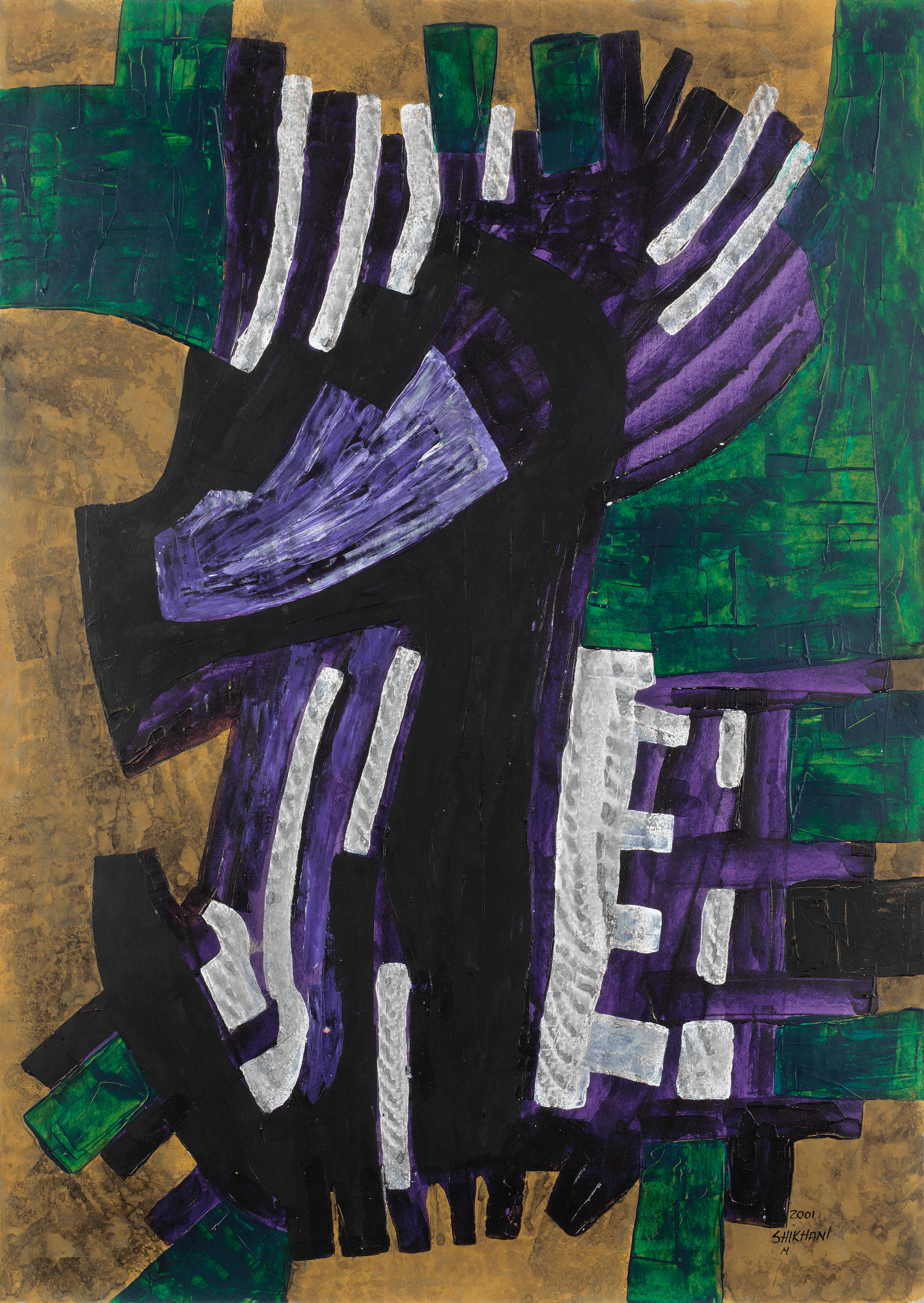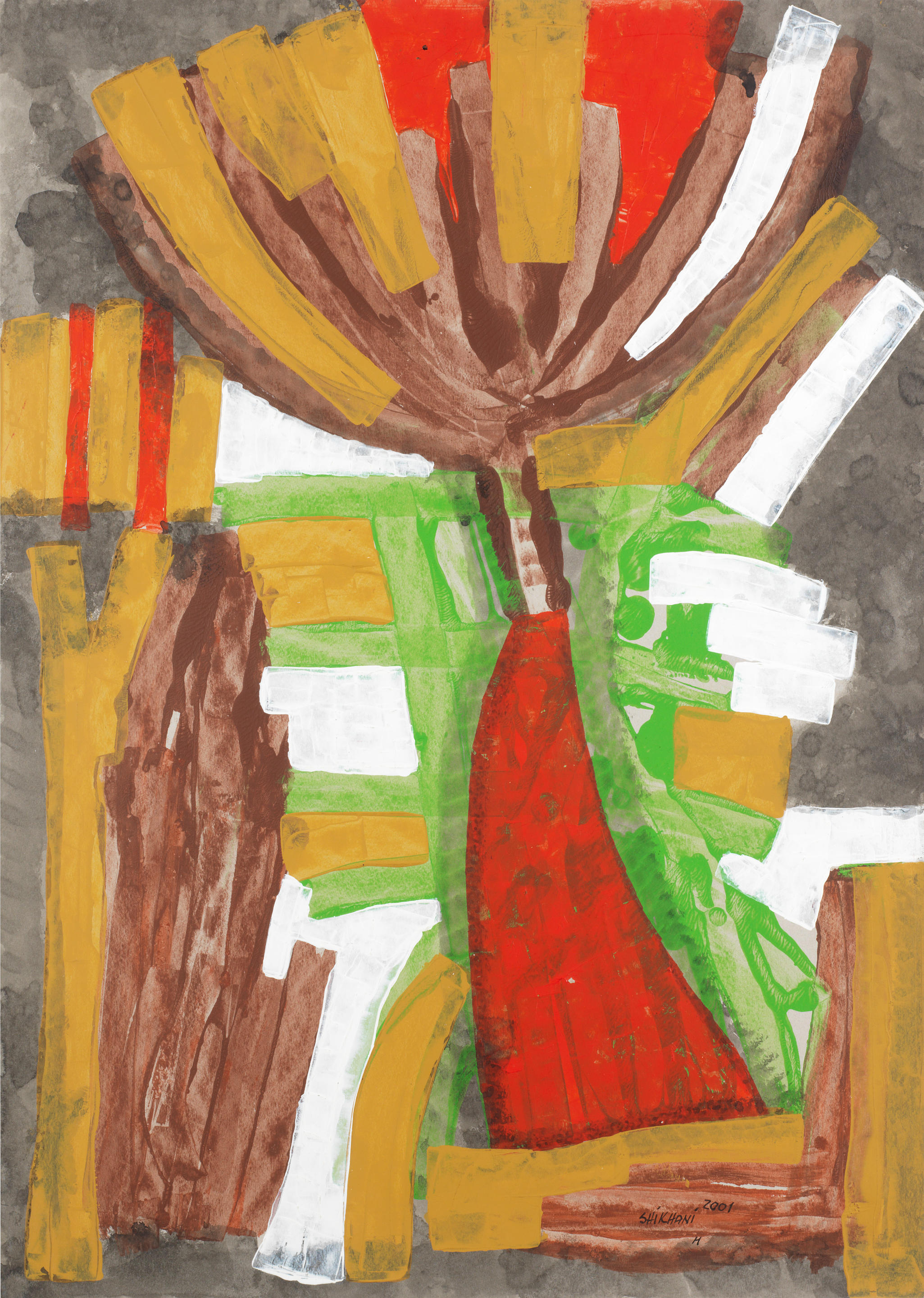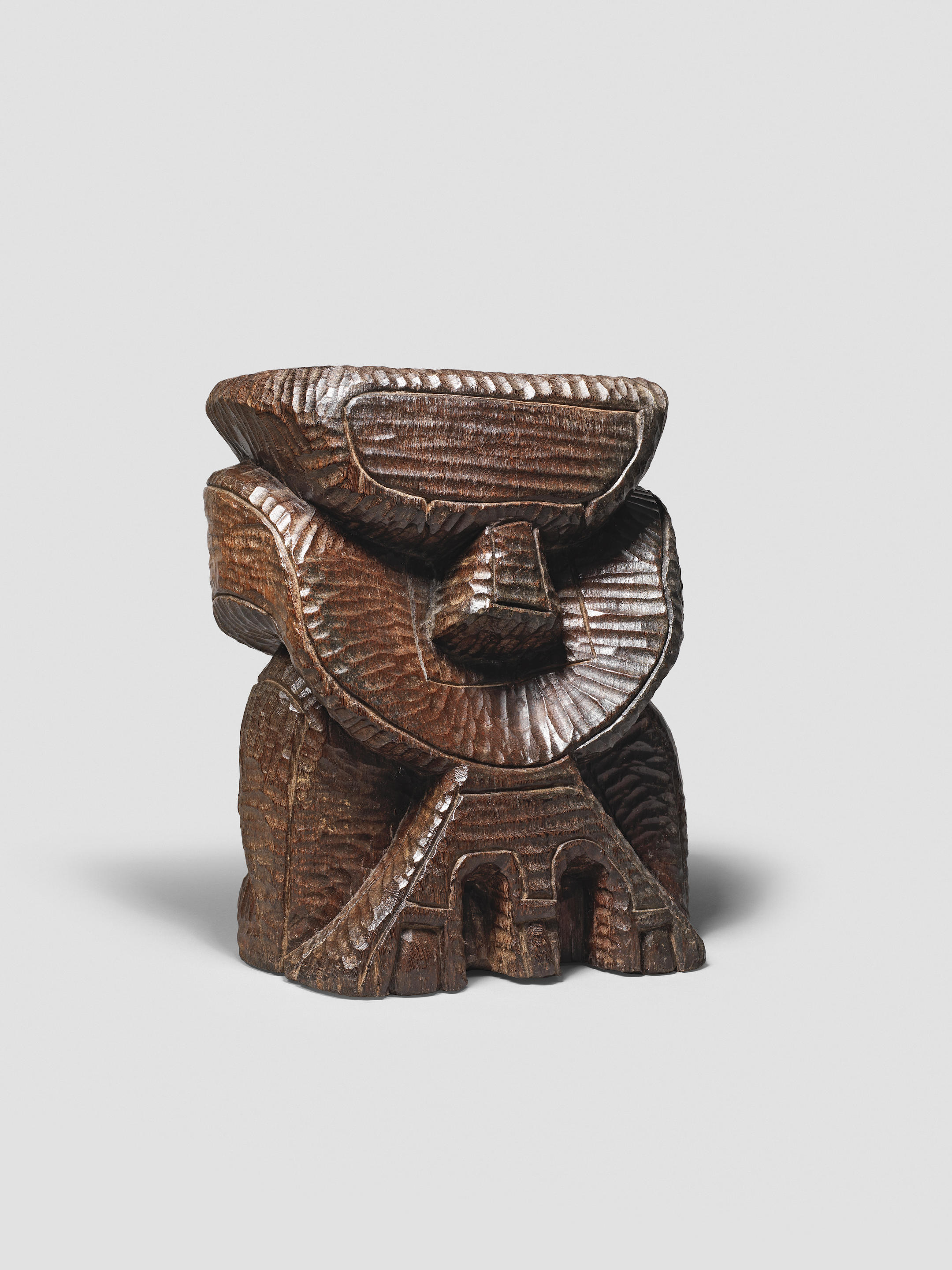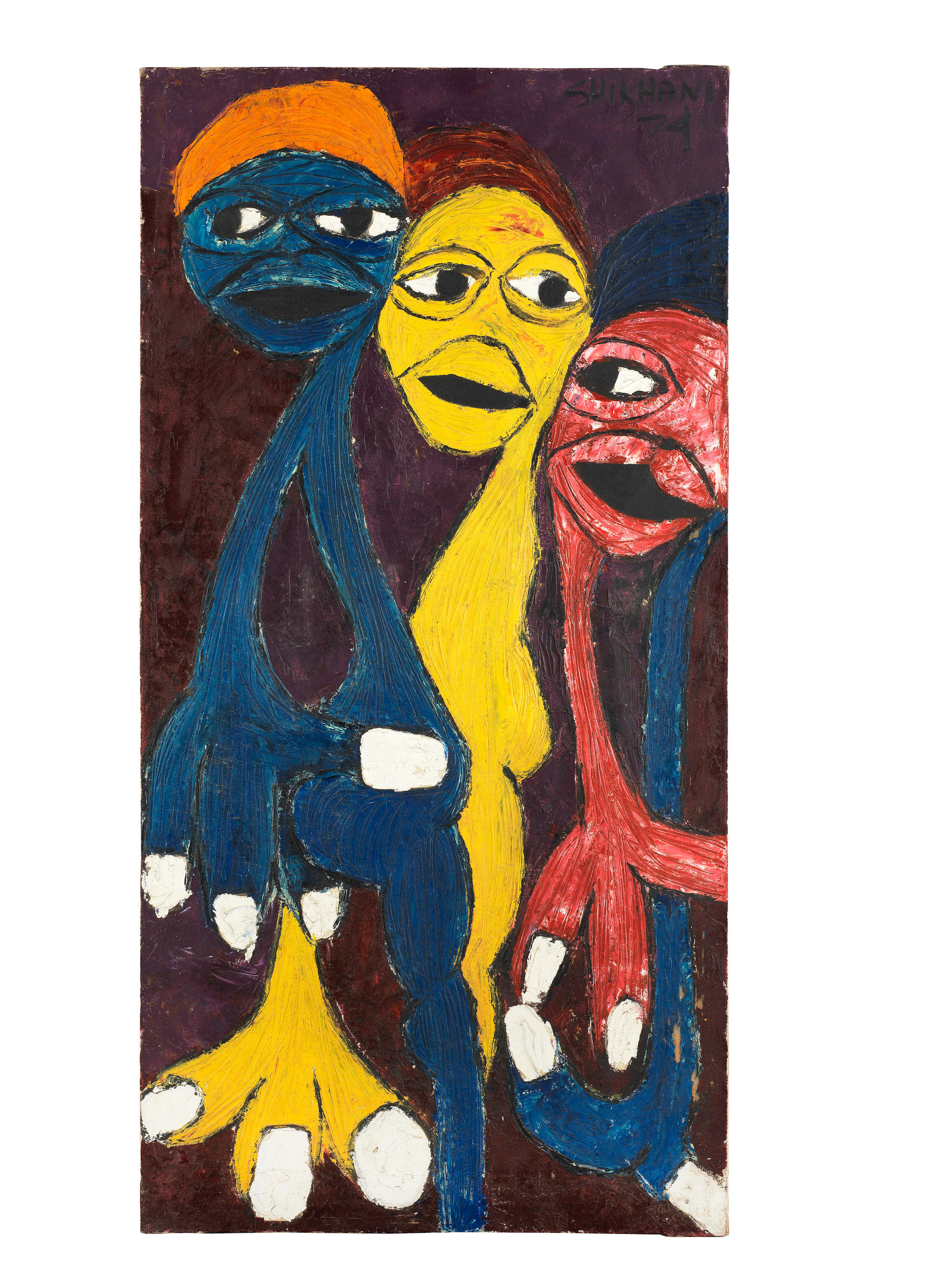Ernesto Shikhani (Mozambique, 1934-2010)The Last Supper, 1977 signé et daté en bas à droite "Shikhani, 1977" huile sur toile signed and dated "Shikhani, 1977" to the lower right oil on canvas 100 x 200cm. 39 3/8 x 78 3/4in. FootnotesProvenance Hotel Pinhal Ofir - Esposende, Portugal (don de l'artiste) Collection privée, Portugal Puis par descendance au propriétaire actuel Ernesto Shikhani est né en 1934 dans la région de Muvesha au Mozambique. Dès le début de son apprentissage artistique il se consacre à la sculpture, guidé par le maître portugais Lobo Fernandes alors enseignant au Núcleo de Arte, à Maputo. Son travail est empreint d'un mélange audacieux, à mi-chemin entre les pratiques artistiques traditionnelles mozambicaines et les propositions plastiques contemporaines de l'époque. Cette toile est réalisée en 1977, trois ans après la signature du traité d'indépendance du Mozambique. Accord précédé d'une lutte pour la liberté qui entraina dix années de guerre civile avec le Portugal, laissant derrière elle un pays profondément marqué par la violence. Ernesto Shikhani, comme d'autres artistes mozambicains témoins de l'injustice sociale des anciennes colonies portugaises, met son art au service d'un nationalisme mozambicain naissant et assumé. Beaucoup d'entre eux seront cependant censurés par la Police de renseignement portugaise (PIDE) sous l'égide d'un gouvernement encore en proie aux maximes religieuses et racistes de l'époque. Cette œuvre représente une des plus célèbres scènes bibliques, la Cène, illustrant Jésus entouré de ses apôtres. À la seule différence que les personnages sont ici de couleur noire, une attaque évidente à la mentalité suprémaciste blanche qui imprégnait alors les mœurs coloniales portugaises au Mozambique. Lors d'un séjour au Portugal à l'été 1977, il fait cadeau de cette toile à l'hôtel de Pinhal Ofir – Esposende, où il réside. L'Hôtel confie alors la toile à une société d'encadrement, appartenant à la famille de l'actuel propriétaire. Dans le contrat, chose assez classique à l'époque, est mentionné que si l'œuvre n'est pas récupérée au bout d'un an elle deviendrait la propriété de l'encadreur. L'Hôtel Pinhal Ofir n'alla jamais chercher l'œuvre, jugée trop polémique par le gouvernement portugais. When commencing his artistic training in Mozambique, Ernesto Shikhani first dedicated himself to sculpture, guided by the Portuguese master Lobo Fernandes who was then a teacher at the Núcleo de Arte school of Maputo. From 1970, he expanded his practice to also focus on painting. Shikhani's work is marked by a bold hybridity – he fuses traditional Mozambican artistic practices with contemporary approaches to artmaking. The present work was created in 1977, three years after Mozambique secured independence from Portuguese colonial rule. This liberation was preceded by a struggle for freedom that had resulted in a decade-long civil war, leaving behind a country deeply marked by violence. Ernesto Shikhani, like other Mozambican artists who witnessed the social injustices of the former Portuguese colonial rule, put his art to the service of a nascent nationalism. Many of his works were censored by the Portuguese Intelligence Police (PIDE) who worked under the aegis of a government still caught in the grip of the religious and racist maxims prevalent in this period. The work represents one of the best-known biblical scenes, The Last Supper, and portrays Jesus and his apostles gathered around a table. The only difference in Shikhani's work is that the characters are portrayed as black, a provocation to the white supremacist mentality that impregnated the lingering colonial ideologies prevalent in Mozambique at the time. During his visit to Portugal in the summer of 1977, Shikhani donated the present work to the Hotel de Pinhal Ofir-Esposende, where he stayed. The hotel entrusted the painting to a framing company belonging to the family of the current owner. In the framing contract it was written that if the wor
Ernesto Shikhani (Mozambique, 1934-2010)The Last Supper, 1977 signé et daté en bas à droite "Shikhani, 1977" huile sur toile signed and dated "Shikhani, 1977" to the lower right oil on canvas 100 x 200cm. 39 3/8 x 78 3/4in. FootnotesProvenance Hotel Pinhal Ofir - Esposende, Portugal (don de l'artiste) Collection privée, Portugal Puis par descendance au propriétaire actuel Ernesto Shikhani est né en 1934 dans la région de Muvesha au Mozambique. Dès le début de son apprentissage artistique il se consacre à la sculpture, guidé par le maître portugais Lobo Fernandes alors enseignant au Núcleo de Arte, à Maputo. Son travail est empreint d'un mélange audacieux, à mi-chemin entre les pratiques artistiques traditionnelles mozambicaines et les propositions plastiques contemporaines de l'époque. Cette toile est réalisée en 1977, trois ans après la signature du traité d'indépendance du Mozambique. Accord précédé d'une lutte pour la liberté qui entraina dix années de guerre civile avec le Portugal, laissant derrière elle un pays profondément marqué par la violence. Ernesto Shikhani, comme d'autres artistes mozambicains témoins de l'injustice sociale des anciennes colonies portugaises, met son art au service d'un nationalisme mozambicain naissant et assumé. Beaucoup d'entre eux seront cependant censurés par la Police de renseignement portugaise (PIDE) sous l'égide d'un gouvernement encore en proie aux maximes religieuses et racistes de l'époque. Cette œuvre représente une des plus célèbres scènes bibliques, la Cène, illustrant Jésus entouré de ses apôtres. À la seule différence que les personnages sont ici de couleur noire, une attaque évidente à la mentalité suprémaciste blanche qui imprégnait alors les mœurs coloniales portugaises au Mozambique. Lors d'un séjour au Portugal à l'été 1977, il fait cadeau de cette toile à l'hôtel de Pinhal Ofir – Esposende, où il réside. L'Hôtel confie alors la toile à une société d'encadrement, appartenant à la famille de l'actuel propriétaire. Dans le contrat, chose assez classique à l'époque, est mentionné que si l'œuvre n'est pas récupérée au bout d'un an elle deviendrait la propriété de l'encadreur. L'Hôtel Pinhal Ofir n'alla jamais chercher l'œuvre, jugée trop polémique par le gouvernement portugais. When commencing his artistic training in Mozambique, Ernesto Shikhani first dedicated himself to sculpture, guided by the Portuguese master Lobo Fernandes who was then a teacher at the Núcleo de Arte school of Maputo. From 1970, he expanded his practice to also focus on painting. Shikhani's work is marked by a bold hybridity – he fuses traditional Mozambican artistic practices with contemporary approaches to artmaking. The present work was created in 1977, three years after Mozambique secured independence from Portuguese colonial rule. This liberation was preceded by a struggle for freedom that had resulted in a decade-long civil war, leaving behind a country deeply marked by violence. Ernesto Shikhani, like other Mozambican artists who witnessed the social injustices of the former Portuguese colonial rule, put his art to the service of a nascent nationalism. Many of his works were censored by the Portuguese Intelligence Police (PIDE) who worked under the aegis of a government still caught in the grip of the religious and racist maxims prevalent in this period. The work represents one of the best-known biblical scenes, The Last Supper, and portrays Jesus and his apostles gathered around a table. The only difference in Shikhani's work is that the characters are portrayed as black, a provocation to the white supremacist mentality that impregnated the lingering colonial ideologies prevalent in Mozambique at the time. During his visit to Portugal in the summer of 1977, Shikhani donated the present work to the Hotel de Pinhal Ofir-Esposende, where he stayed. The hotel entrusted the painting to a framing company belonging to the family of the current owner. In the framing contract it was written that if the wor















Try LotSearch and its premium features for 7 days - without any costs!
Be notified automatically about new items in upcoming auctions.
Create an alert